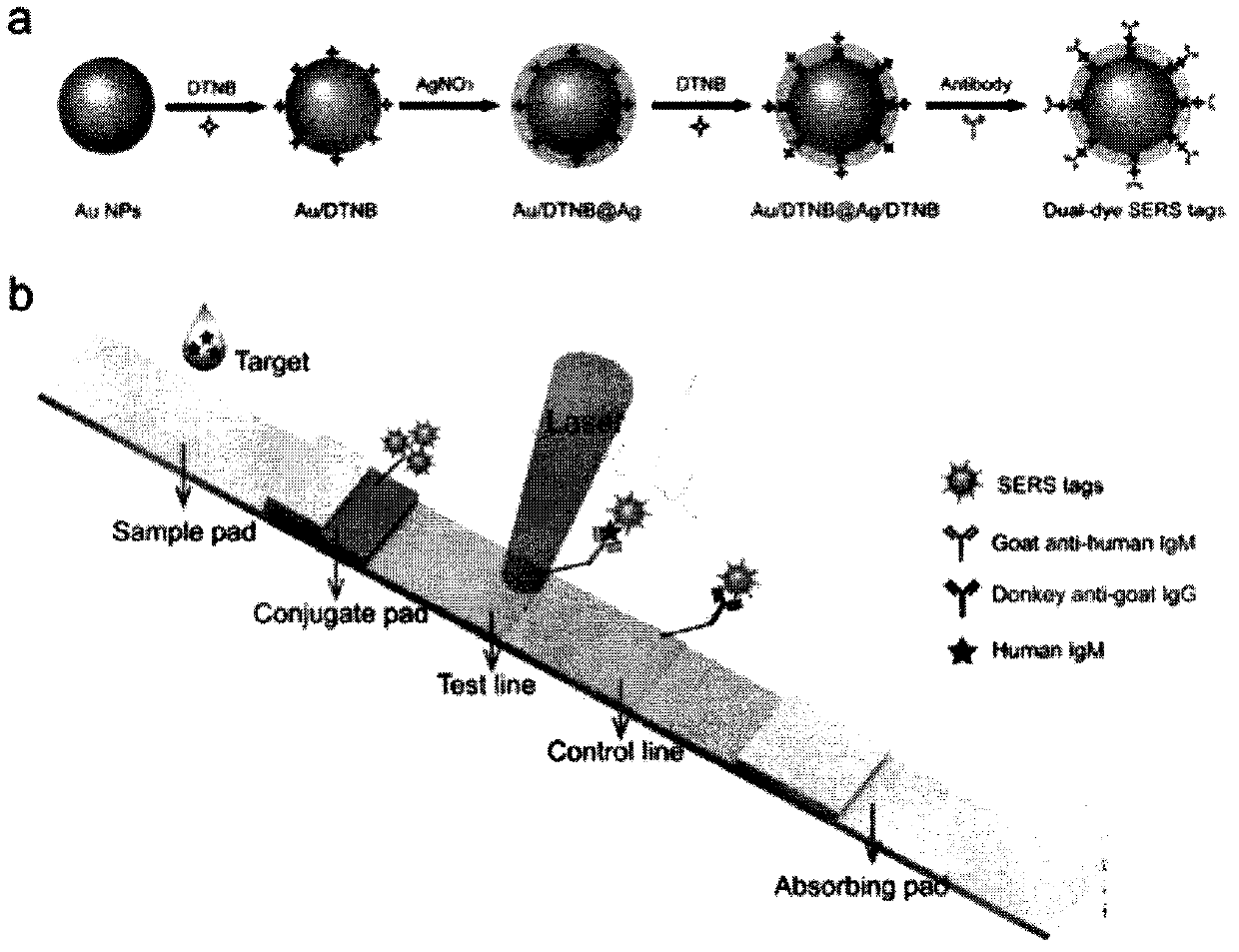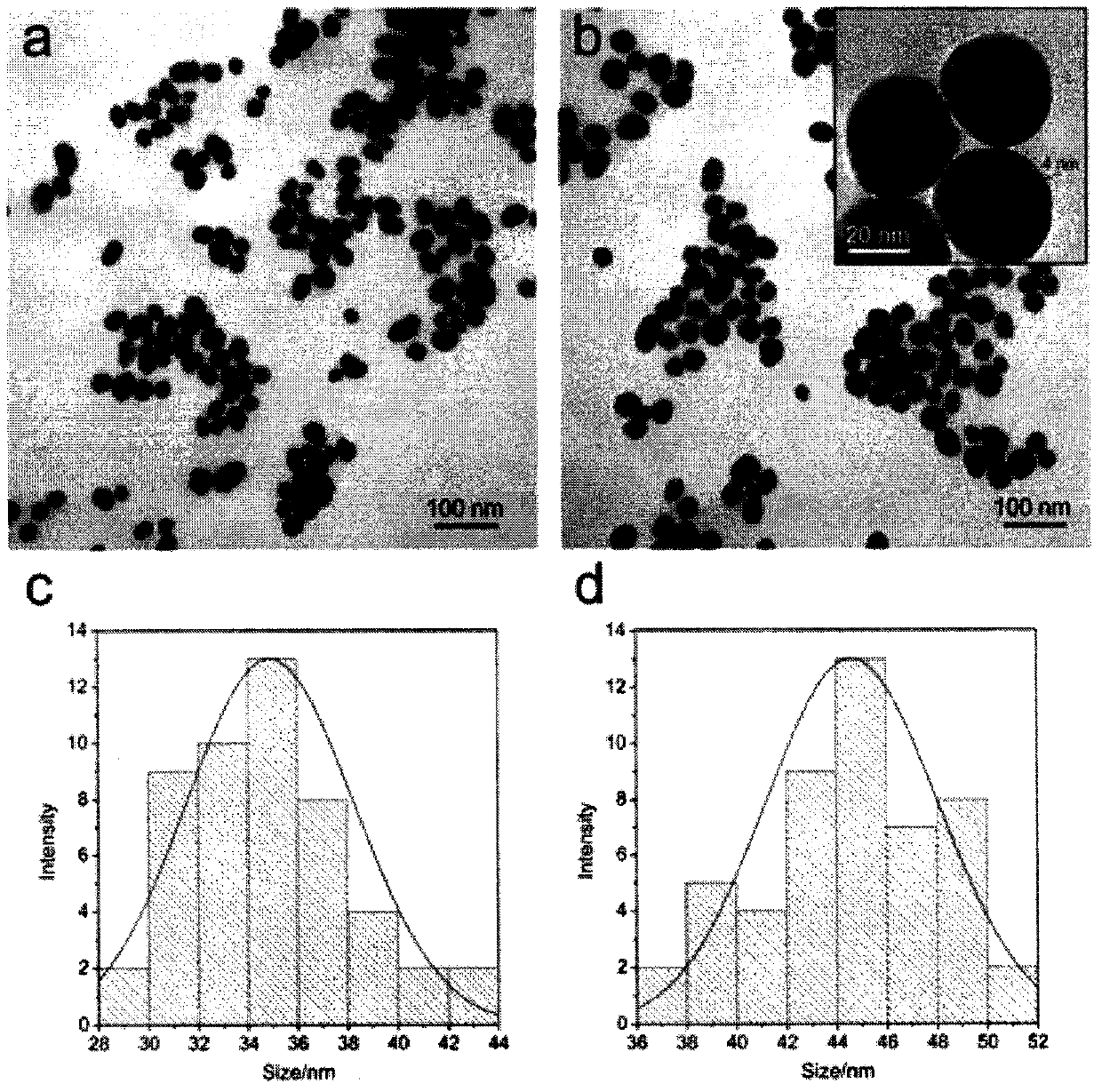SERS-immunochromatography detection method for rapidly and highly sensitively detecting Mycoplasma pneumoniae infection
A technology for immunochromatographic detection and mycoplasma pneumoniae, which is applied in measuring devices, analytical materials, biological testing, etc., can solve the problems of low detection sensitivity, achieve high sensitivity, simple detection process, and improve detection sensitivity
- Summary
- Abstract
- Description
- Claims
- Application Information
AI Technical Summary
Problems solved by technology
Method used
Image
Examples
Embodiment 1
[0038] Example 1, Characterization of Au / DTNB@Ag / DTNB SERS probe
[0039] Experimental procedure: In this experiment, 1.5mL of 1wt% sodium citrate solution was added to 100mL of boiling 0.01wt% chloroauric acid solution, kept boiling for 15 minutes, and then cooled to room temperature. The particle size of AuNPs prepared by this parameter is about 35nm. 10 μL of 10 mM DTNB ethanol solution was added to 10 mL of AuNPs solution, and the mixture was stirred at room temperature for 4 hours. Centrifuge at 8000 rpm for 8 minutes to remove excess DTNB molecules, resuspend the pellet in 10 mL of deionized water, dilute 10 mL of Au NPs / DTNB solution fourfold with deionized water and boil. Subsequently, 0.5 mL of sodium citrate (1%, w / v) was added to the solution and stirred. Finally, 1 mL of silver nitrate (1 mM) was added dropwise to the above solution, stirred and boiled for 15 minutes. At this stage, the solution of Au NPs turned orange-yellow, indicating the formation of Au / DTNB...
Embodiment 2
[0041] Embodiment 2, SERS-immunochromatography test strip quantitatively detects and analyzes the result of human IgM
[0042] Experimental procedure: Dilute human IgM sequentially to 1000ng mL -1 , 100ng mL -1 , 10ng mL -1 , 1ng mL -1 , 0.5ng mL -1 and 0.1ng mL -1 A total of six concentrations, 1×pBST (1×PBS, 0.05% Tween-20) as a blank control; take 70 μL of the sample solution and add it to the sample area of the SERS-immunochromatography test strip in turn, and use Raman after 15 minutes The spectrometer detects the Raman signal in the detection zone. Draw Raman Peak 1335cm -1 SERS signal intensity and human IgM concentration (0.1-1000ngmL -1 ) calibration curve between logarithms. at 1335cm -1 Draw the SERS spectrum in an extended area (250 μm × 50 μm) with a step size of 5 μm to obtain the uniformity result of the SERS signal on the detection line.
[0043] Experimental results: When the concentration of human IgM increases, due to the formation of many immune...
Embodiment 3
[0044] Embodiment 3, SERS immunochromatographic test strip detects the result of 20 routine pulmonary branch IgM positive serum specimens
[0045] Experimental procedure: 20 cases of pulmonary branch-specific IgM-positive clinical serum samples and 10 cases of pulmonary branch-specific IgM-negative clinical serum samples were detected with SERS-immunochromatographic test strips. After mixing 10 μL of clinical serum and 60 μL of sodium chloride solution (w / v), it was added dropwise to the sample pad of the prepared SERS-immunochromatography test strip, and the result was detected after 15 minutes. Based on the immune reaction and chromatography, the lung branch-specific IgM-positive serum samples will form two red detection lines and control lines visible to the naked eye, and the lung branch-specific IgM-negative serum samples will only form a red control line visible to the naked eye . Detection and analysis come from SERS-immunochromatography test strip detection line 1335c...
PUM
| Property | Measurement | Unit |
|---|---|---|
| Particle size | aaaaa | aaaaa |
| The average particle size | aaaaa | aaaaa |
| The average particle size | aaaaa | aaaaa |
Abstract
Description
Claims
Application Information
 Login to View More
Login to View More - R&D
- Intellectual Property
- Life Sciences
- Materials
- Tech Scout
- Unparalleled Data Quality
- Higher Quality Content
- 60% Fewer Hallucinations
Browse by: Latest US Patents, China's latest patents, Technical Efficacy Thesaurus, Application Domain, Technology Topic, Popular Technical Reports.
© 2025 PatSnap. All rights reserved.Legal|Privacy policy|Modern Slavery Act Transparency Statement|Sitemap|About US| Contact US: help@patsnap.com



